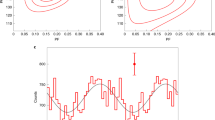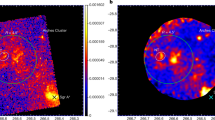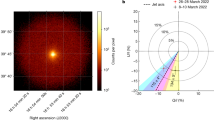Abstract
SEVERAL authors1,2 have suggested that synchrotron radiation by relativistic electrons in galactic magnetic fields may be responsible for part of the galactic background radiation at radio-frequencies. Radiation so produced is linearly polarized in a direction perpendicular to the magnetic field. The actual polarization observed from an extended region is likely to be reduced due to a number of mechanisms3,4 which will be discussed elsewhere, but a small percentage might remain. Razin5 has described an attempt to measure this polarization by a method based on the suggestion that the Faraday effect in interstellar space would make the angular position of the plane of polarization strongly dependent upon frequency. By switching between a wide and a narrow receiver band-width, a change of output was noted which was interpreted as implying the presence of up to 4 per cent of linear polarization in some directions. On present evidence, the magnitude of the galactic magnetic field and of the electron density in interstellar space4 are thought insufficient for this dependence on frequency to lead to a reliable method of measurement, and a different procedure has been adopted. In the present method, a receiver band-width of 4 Mc./s. has been used, and although in certain circumstances the wider band-width might lead to a reduction of the polarization observed, the sensitivity is much improved, particularly when observing in directions away from the galactic plane.
This is a preview of subscription content, access via your institution
Access options
Subscribe to this journal
Receive 51 print issues and online access
$199.00 per year
only $3.90 per issue
Buy this article
- Purchase on Springer Link
- Instant access to full article PDF
Prices may be subject to local taxes which are calculated during checkout
Similar content being viewed by others
References
Shklovsky, I. S., Astro. Zh., 29, 418 (1952).
Burbridge, G. R., Astrophys. J., 123, 178 (1956).
Getmansev, G. G., and Resin, B. A., Proc. of Fifth Conf. on Cosmogony, 496 (Moscow, 1956).
Oort, J. H., and Walraven, Th., Bull. Astro. Neth., 12, 285 (1956).
Razin, B. A., Rad. I. Elek., 1, 846 (1956).
Ryle, M., Proc. Roy. Soc., A, 211, 351 (1952).
Baldwin, J. E., Mon. Not. Roy. Astro. Soc., 115, 690 (1955).
Author information
Authors and Affiliations
Rights and permissions
About this article
Cite this article
THOMSON, J. An Attempt to detect Linearly Polarized Radio Emmision from the Galaxy. Nature 180, 495–496 (1957). https://doi.org/10.1038/180495b0
Issue Date:
DOI: https://doi.org/10.1038/180495b0
This article is cited by
-
Polarization of Galactic Radio Emission at λ 1.25 m
Nature (1968)
-
Measuring the linear polarization of background cosmic radiation
Radiophysics and Quantum Electronics (1968)
-
A method of measuring the linear polarization of distributed cosmic radiation
Soviet Radiophysics (1967)
-
Faraday Rotation of Polarized Galactic Radio Emission
Nature (1962)
Comments
By submitting a comment you agree to abide by our Terms and Community Guidelines. If you find something abusive or that does not comply with our terms or guidelines please flag it as inappropriate.



